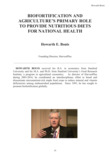Biofortification and Agriculture’s Primary Role to Provide Nutritious Diets for National Health

Fundamentally, the prevalence of mineral and vitamin deficiencies is high in developing countries due to fact that agricultural systems do not produce sufficient foods rich in minerals and vitamins. During 1960-2000, the Green Revolution successfully increased cereal production faster than rapidly growing populations, where limited land was available to expand agricultural production. However, there were not the same investments in increasing agricultural productivity for non-staple food groups. Consequently, prices for these food groups - vegetables, fruits, pulses, animal products, which provide dietary quality - rose rapidly. The prices that consumers pay for iron, zinc, and provitamin A have increased significantly. Looking to the future, many in agricultural community now recognize that agriculture has a fundamental responsibility to produce these minerals and vitamins to secure national health.
Biofortification involves breeding staple food crops to increase their micronutrient content, targeting staple foods widely consumed by low-income families globally. In so doing, biofortification contributes to solving the underlying problem of mineral and vitamin deficiencies by increasing the amount of iron, zinc and provitamin A produced by food systems Biofortification:
- Taps into the effectiveness and cost-effectiveness of plant breeding as well as of seeds to replicate themselves, where the results of research undertaken in a central location can be replicated in other countries.
- Minimizes the need for behaviour change by: (i) piggybacking on an existing system of agricultural research institutes (international and national) that produces a stream of increasingly productive and climate-adapted crop varieties that are adopted by farmers and eventually account for a high percentage of total food supplies; and (ii) focusing on food staples that the poor already eat in large quantities.
- Provides extra iron, zinc and provitamin A to farmers and consumers at no extra cost by growing and eating biofortified varieties of everyday foods in a one-for-one substitution for non-biofortified varieties and initiates the delivery of these micronutrients in the relatively hard-to-reach rural areas where a majority of the poor reside.
When HarvestPlus first started in 2003, there was much doubt among a range of stakeholders, that biofortification would work First, we had to prove to the plant science community that higher target levels iron, zinc, and provitamin A could be bred into high- yielding, profitable varieties. Presently, over 100 varieties of twelve biofortified crops have passed the agronomic tests of varietal release committees in 30 developing countries. In 3-5 years, biofortified varieties will be available to farmers and consumers in an additional 30 countries.
The nutrition community initially questioned the efficacy of biofortified crops - would the levels of retained nutrients and absorption be high enough? HarvestPlus has commissioned fifteen efficacy trials, all undertaken in developing countries. While five of these studies are still in process, there is already sufficient positive published evidence for iron and provitamin A, that the World Health Organization is now undertaking a systematic review of the evidence This review will be completed and findings published by the WHO in 2017.
Can adoption of biofortified crops by farmers be scaled up, and a public health impact demonstrated? For example just four years after release of high-yielding, iron bean varieties in Rwanda, we now have rigorous evidence that 30% of farmers in Rwanda are growing biofortified beans on a regular basis. HarvestPlus estimates that 20 million farmers and consumers presently grow and consume biofortified crops in eight target countries.
The final and major challenge is to mainstream biofortification into the fabric of "business-as-usual" of a range of organizations - public and private agricultural research, institutions that focus on bringing improved agricultural technologies to farmers including multi-lateral lending institutions, private companies, non-governmental organizations, and the policies and programs of national governments, regional organizations, and UN agencies. The vision of HarvestPlus is that by 2030, one billion people will be reached by biofortified crops.
| Alternative title | 栄養強化作物の開発による健康な食生活の実現 |
|---|---|
| Date of issued | |
| Creator | Howarth Bouis |
| Publisher | Japan International Research Center for Agricultural Sciences |
| Available Online | |
| NII resource type vocabulary | Conference Paper |
| Issue | 2017 |
| spage | 19 |
| epage | 26 |
